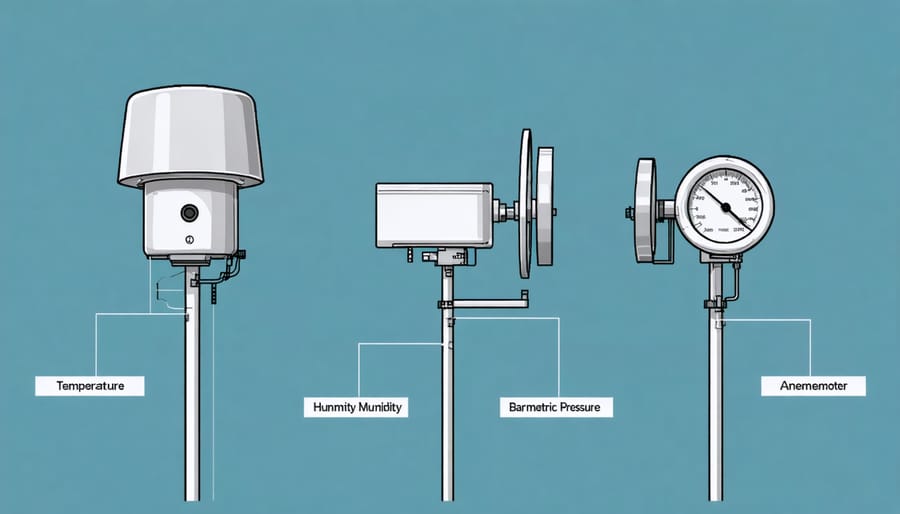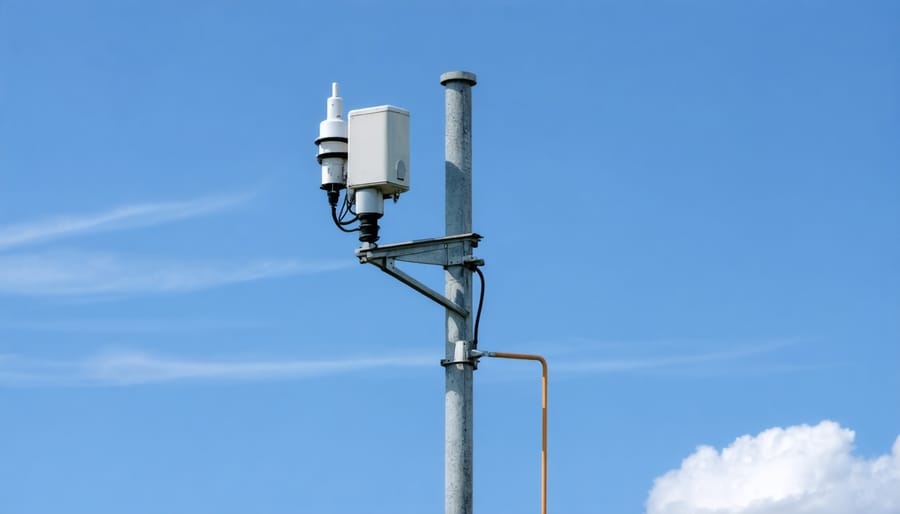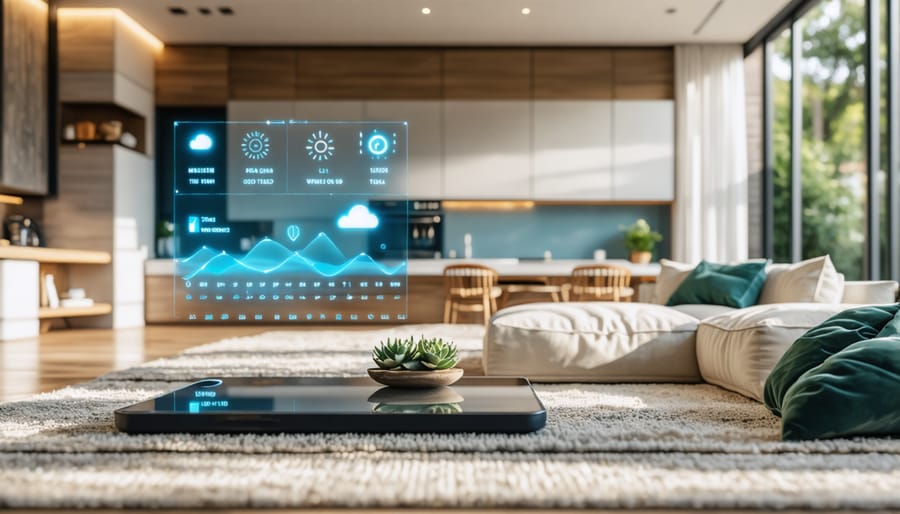Transform your backyard into a personal weather command center with a 3-sensor weather station – your gateway to hyperlocal weather monitoring and smart home automation. These compact powerhouses measure temperature, humidity, and barometric pressure, delivering professional-grade accuracy without the complexity of larger systems.
Whether you’re a gardening enthusiast tracking frost warnings, a smart home buff automating your HVAC system, or simply someone who wants to know exactly when to grab an umbrella, a 3-sensor weather station provides the precise data you need. Modern units sync seamlessly with smartphones and home automation systems, putting real-time weather insights right at your fingertips.
In this guide, we’ll walk through everything you need to know about choosing, setting up, and maximizing a 3-sensor weather station for your home. From optimal placement strategies to wireless connectivity options, you’ll discover how these affordable weather monitoring solutions can enhance your daily life while adding a layer of environmental awareness to your smart home setup.
Essential Components of a 3-Sensor Weather Station

Temperature and Humidity Sensor
The temperature and humidity sensor is the heart of your weather station, giving you essential data about your indoor or outdoor environment. This versatile component uses advanced sensing technology to measure both air temperature and relative humidity with impressive accuracy. Most modern sensors can detect temperatures ranging from -40°F to 140°F (-40°C to 60°C) and humidity levels from 0% to 100%.
What makes this sensor particularly valuable is its dual-monitoring capability. You’ll get real-time readings of both metrics, helping you make informed decisions about your home’s climate control. The sensor typically updates its measurements every few seconds, ensuring you always have current data at your fingertips.
For the best results, place your sensor in a sheltered location away from direct sunlight and rain. If you’re monitoring outdoor conditions, consider installing it inside a ventilated radiation shield. This protective housing helps ensure accurate readings by preventing solar radiation from artificially warming the sensor while still allowing proper airflow.
Many modern temperature and humidity sensors also include wireless connectivity, making it easy to access your readings through a smartphone app or home automation system.
Barometric Pressure Sensor
The barometric pressure sensor is your weather station’s window into atmospheric changes, helping you predict weather patterns before they arrive. This clever device measures the weight of the air above us, giving you valuable insights about incoming weather fronts. When pressure rises, it typically signals fair weather ahead, while falling pressure often warns of approaching storms or precipitation.
Modern pressure sensors are incredibly accurate and compact, usually measuring in hectopascals (hPa) or inches of mercury (inHg). For home weather monitoring, look for sensors with a measurement range of 300-1100 hPa, which covers most weather conditions you’ll encounter. The best part? These sensors can detect subtle pressure changes hours before visible weather changes occur, giving you a helpful heads-up for planning outdoor activities or preparing for incoming weather.
Wind Speed Sensor (Anemometer)
The anemometer is your weather station’s trusty wind speed detector, consisting of cup-shaped sensors that spin faster or slower depending on wind velocity. As the cups rotate, the sensor converts this movement into electrical signals, giving you accurate readings in miles per hour (mph) or kilometers per hour (km/h). Most modern anemometers can detect winds from 0 to 100 mph, perfect for monitoring everything from gentle breezes to strong storms.
The sensor typically mounts at the highest point of your weather station to avoid interference from buildings or trees. For the most accurate readings, install it at least 33 feet (10 meters) above ground level. Many models also include built-in bearings that ensure smooth operation and extended durability, even in harsh weather conditions.
Remember to clean the cups periodically and check that they spin freely to maintain accuracy. A well-maintained anemometer will provide reliable wind speed data for years to come.
Setting Up Your Weather Station
Choosing the Perfect Location
Finding the perfect spot for your 3-sensor weather station is crucial for accurate readings and long-term reliability. Start by choosing an open area away from buildings, trees, and other obstacles that could interfere with wind and rain measurements. Ideally, mount your sensors at least 5-6 feet away from any structures and avoid placing them under eaves or overhangs.
For the temperature sensor, look for a location that’s well-ventilated but sheltered from direct sunlight. A north-facing position is often ideal, as it minimizes solar radiation effects that could skew your readings. Consider installing a small radiation shield if your chosen spot receives occasional sun exposure.
The rain gauge needs a level surface with clear overhead space to ensure accurate precipitation measurements. Make sure there are no nearby trees or structures that could funnel water into the gauge or block rainfall from reaching it.
When positioning the wind sensor, height matters! Install it at least 6 feet above nearby obstructions for the most accurate readings. The top of a pole mount or the peak of your roof can work well, but ensure it’s securely fastened to withstand strong gusts.
Remember to consider accessibility for maintenance and battery changes. While you want optimal placement, you also need to reach your sensors safely when it’s time for upkeep. A location that balances accuracy with practicality will serve you best in the long run.

Installation Steps
Setting up your 3-sensor weather station is easier than you might think! Let’s walk through the process step by step to ensure you get the most accurate readings possible.
First, choose an ideal mounting location. Your sensors should be at least 5 feet above the ground and away from heat-reflecting surfaces like concrete or asphalt. The temperature/humidity sensor needs proper ventilation and protection from direct sunlight – consider installing it under an eave or using a radiation shield.
For the anemometer (wind sensor), height is crucial. Mount it on a sturdy pole at least 33 feet from any obstacles, if possible. If you’re installing on your roof, ensure it extends at least 6 feet above the roofline to avoid turbulence effects.
The rain gauge should be level and positioned away from trees or buildings that could block precipitation. Use a bubble level during installation to ensure accurate measurements.
Pro tip: Before permanent mounting, temporarily set up your station and monitor readings for 24 hours to confirm you’ve chosen optimal locations.
For the main console setup:
1. Install fresh batteries or connect power adapter
2. Place the console within range of all sensors (typically 300 feet maximum)
3. Follow your manufacturer’s sync process to connect all sensors
4. Set your local time, altitude, and pressure settings
Remember to check sensor batteries every 6-12 months and clean the rain gauge seasonally. For winter operation in cold climates, consider removing the rain gauge to prevent freeze damage.
With proper installation, your weather station will provide reliable data for years to come!
Connecting to Your Smart Home
Integrating your 3-sensor weather station with your home automation system opens up a world of smart possibilities. By connecting your weather station to platforms like Home Assistant, SmartThings, or Apple HomeKit, you can create a truly weather-ready smart home that responds to environmental conditions automatically.
Most modern weather stations come with WiFi capability and companion apps that make integration straightforward. Once connected, you can set up automated routines like closing your smart blinds when UV levels are high, adjusting your smart thermostat based on outdoor temperature, or activating your irrigation system according to rainfall measurements.
To get started, ensure your weather station and home automation hub are on the same network. Then, follow your specific platform’s instructions for adding new devices. Many weather stations use standard protocols like MQTT or REST API, making them compatible with multiple systems. Don’t forget to test your automation routines thoroughly before relying on them for daily use.
Making the Most of Your Weather Data
Smart Home Climate Control
Transform your weather station data into an intelligent home climate management system with smart home climate control. By connecting your three-sensor system to your home’s HVAC setup, you can create a responsive environment that adjusts automatically to both indoor and outdoor conditions.
Your weather station’s temperature, humidity, and barometric pressure readings can help your HVAC system work smarter, not harder. For example, when your outdoor sensors detect a significant temperature drop, your system can preemptively adjust indoor heating settings. This prevents your furnace from working overtime and helps maintain consistent comfort levels throughout your home.
Here’s how to make the most of your setup:
– Program your thermostat to respond to outdoor humidity levels
– Set temperature differential triggers for automatic HVAC adjustments
– Create morning and evening routines based on daily weather patterns
– Use pressure readings to prepare for weather changes that affect indoor comfort
The real magic happens when you integrate these sensors with smart vents and zone-based climate control. Your home can automatically redirect airflow to rooms that need it most, based on real-time weather data. This targeted approach not only improves comfort but can lead to significant energy savings – typically 15-20% on your heating and cooling bills.
Remember to position your outdoor sensors away from direct sunlight and heat-reflecting surfaces for the most accurate readings and optimal HVAC performance.

Garden and Lawn Care Optimization
Your 3-sensor weather station can revolutionize the way you care for your garden and lawn by providing real-time data for smarter plant care decisions. By integrating your weather station with automated irrigation control systems, you can optimize watering schedules based on actual weather conditions rather than fixed timers.
The temperature sensor helps you identify the best times for watering, preventing evaporation during hot periods and protecting plants from frost damage. The humidity sensor ensures you’re not overwatering when the air is already moisture-rich, while the rain sensor prevents unnecessary irrigation during or after rainfall.
With precision garden monitoring, you can create customized care routines for different areas of your yard. For example, you might adjust watering cycles for shade-grown plants versus those in direct sunlight, or modify schedules for different soil types in your garden.
The data from your weather station can also help you make informed decisions about:
– When to apply fertilizer (avoiding rainy periods)
– The best times for planting new seedlings
– Protecting sensitive plants from extreme weather
– Adjusting maintenance schedules based on seasonal changes
By tracking weather patterns over time, you’ll develop a deeper understanding of your garden’s microclimate, leading to healthier plants and more efficient resource use. This smart approach to garden care not only saves water and energy but also helps create a more sustainable and thriving outdoor space.
Weather Alerts and Forecasting
One of the most valuable features of a 3-sensor weather station is its ability to keep you informed about changing weather conditions through customizable alerts. Setting up these notifications is straightforward and can help you stay prepared for whatever Mother Nature has in store.
Start by connecting your weather station to your home’s Wi-Fi network and downloading the manufacturer’s companion app. Most modern weather stations allow you to set threshold values for temperature, humidity, and barometric pressure. For example, you might want an alert when temperatures drop below freezing to protect your garden, or when humidity levels rise above 70% to prevent potential mold issues indoors.
Many weather stations also offer forecast predictions based on your local sensor data combined with regional weather information. These forecasts are often more accurate than general weather reports because they factor in your specific microclimate. You can typically choose to receive notifications through smartphone push alerts, email, or even SMS messages.
Consider setting different alert profiles for different seasons. In winter, focus on freeze warnings and sudden pressure changes that might indicate incoming storms. During summer, you might want alerts for high UV index levels or rapid temperature increases that could affect your home’s cooling efficiency.
Remember to periodically review and adjust your alert settings to ensure they remain relevant to your needs and aren’t too frequent to become overwhelming.
Setting up a 3-sensor weather station is more than just adding another gadget to your home – it’s an investment in understanding and preparing for the weather conditions that affect your daily life. With accurate readings of temperature, humidity, and barometric pressure at your fingertips, you’ll be better equipped to plan outdoor activities, protect your garden, and even save on energy costs through more informed climate control decisions.
The beauty of modern weather stations lies in their accessibility and user-friendly design. Whether you’re a weather enthusiast or simply someone who wants to make more informed decisions about your day-to-day activities, these systems offer valuable insights without requiring meteorological expertise.
By taking the step to install your own weather station, you’re joining a growing community of home weather observers who contribute to our collective understanding of local weather patterns. The data you collect can help you develop a deeper connection with your environment while making practical decisions for your household.
Don’t let uncertainty about technology hold you back – today’s weather stations are designed with user-friendliness in mind. Start your weather monitoring journey now, and discover how a simple set of three sensors can transform your approach to weather awareness and home management. Remember, the best time to start monitoring your local weather is today – your future self will thank you for the valuable insights gained.
